9 best print-on-demand sites to sell merch in 2025

Print-on-demand (POD) is a fulfillment model enabling the creation and sale of custom merch without the hassle of inventory management, or printing and shipping responsibilities.
Selecting the right print-on-demand site may be challenging due to numerous options, which is why we’ve reviewed the top 9 print-on-demand sites in 2025.
Sellfy, one of these platforms, stands out with its impressive features like built-in marketing tools (email marketing, upselling, etc.), the ability to upsell non-POD products (digital items), and an all-in-one solution covering online store management, production, and worldwide product delivery.
Sellfy also excels in product range and quality, as well as offering customization options for storefronts and checkouts.
But, before we delve into the details, it’s crucial to note the distinction between a print-on-demand site and a print-on-demand company:
The former serves as a comprehensive solution for creating and selling custom products, providing artists with a simpler and quicker way to profit from their designs compared to a POD company.
1. Sellfy
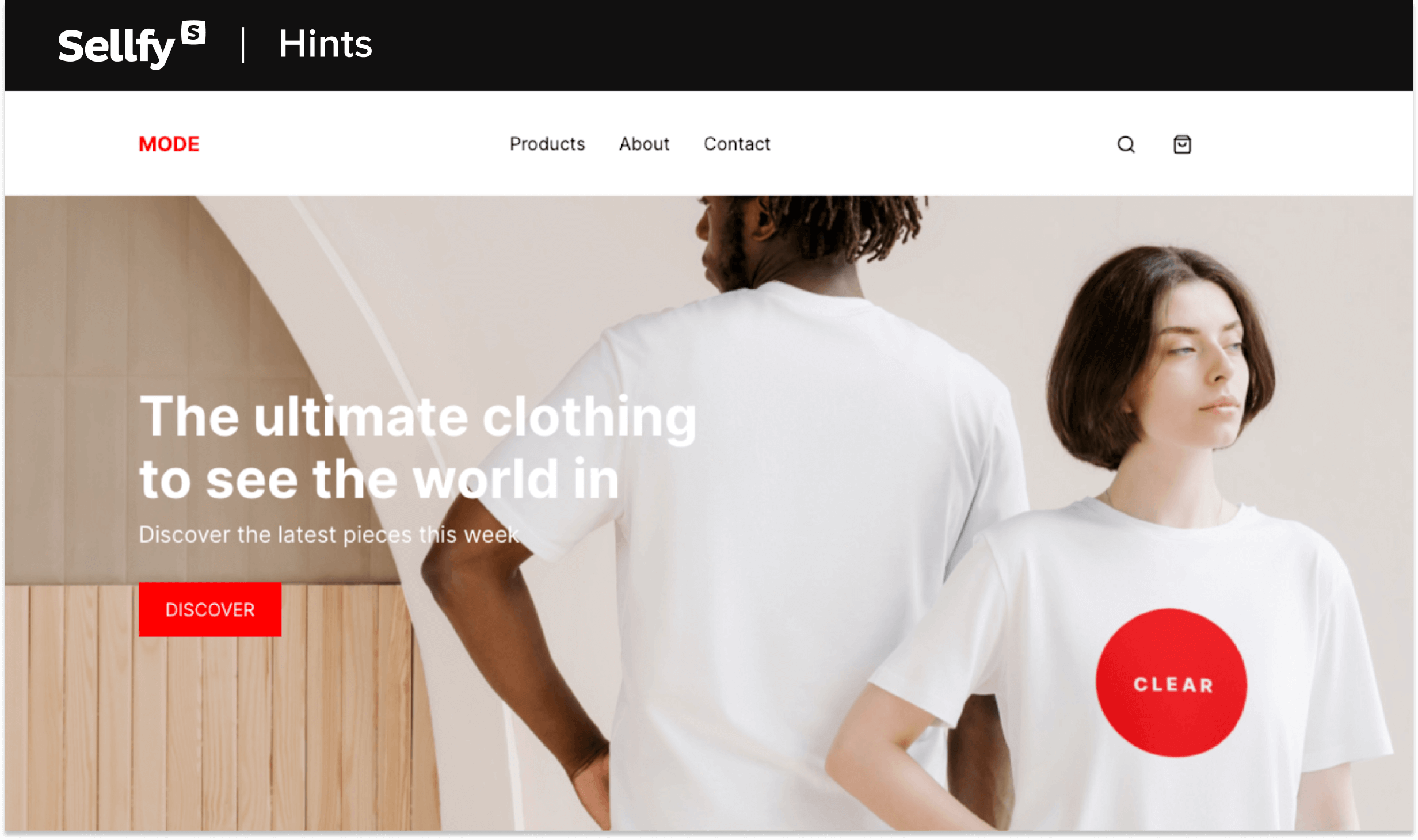
Sellfy is best described as a print-on-demand site with all the perks of a POD company.
In essence, it’s an easy-to-use eCommerce platform for selling digital and physical goods, subscriptions as well as print-on-demand products. Sellfy’s setup process is as smooth as its user interface. In less than 10 minutes, you can create a professional-looking online store, with built-in marketing tools, excellent customer service, and the possibility to embed the “buy now” button on your existing website.
Unlike similar platforms, Sellfy lets you create custom merch and sell it together with other types of custom products—all from one place. All you need to do is choose a print product, upload your custom design, and set a price. The best part is that you can fill your online store with as many items as you like without keeping inventory or worrying about unsold leftovers.
Sellfy takes full care of the fulfillment process. After you make a sale, the order will be automatically sent to production and then shipped worldwide to your customer.
Best for: Any type of creator (or, technically, anybody who wants to sell digital or physical products online).
How you get paid: One of the perks of using Sellfy is that you’ll receive payments directly in your account after each transaction. The base cost of the product and its fulfillment services will only be charged after your customer orders something. It means that you get to decide how much you earn—set your retail prices as high or as low as you want.
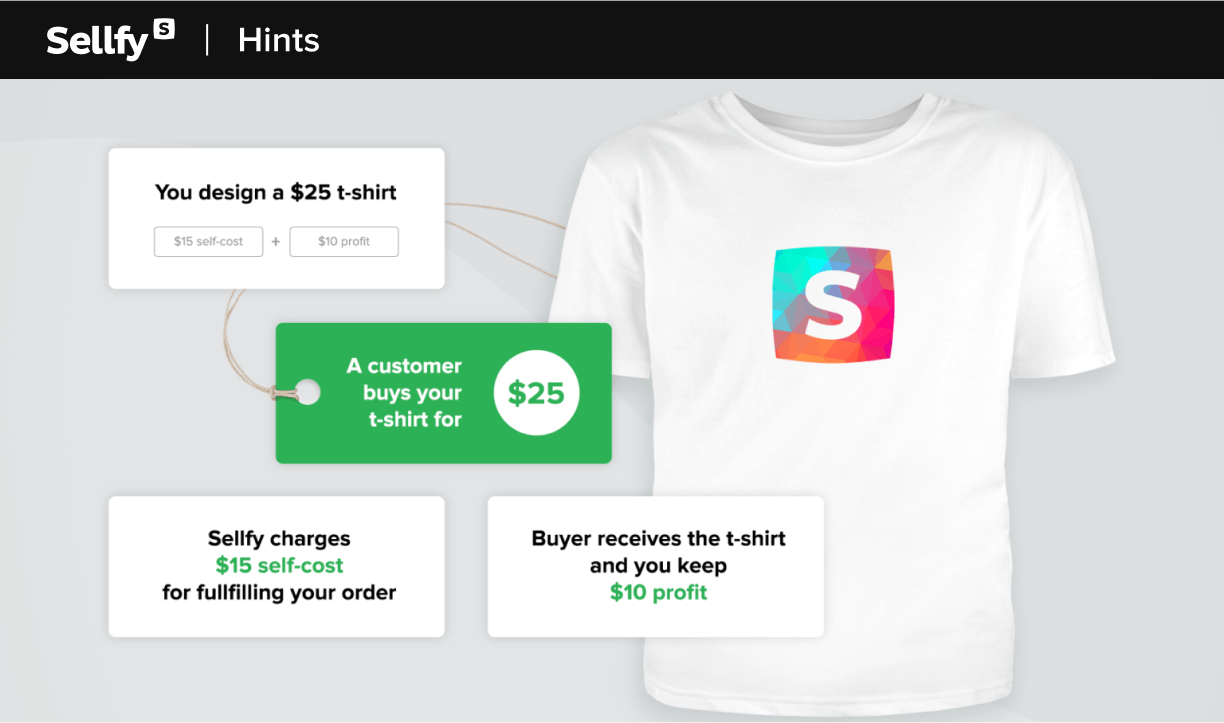
Pros:
- Instant payouts
- Built-in support for all custom products
- Built-in marketing features
- Fully-customizable online store
- Embed the “buy now” button
- Integrate the shopping cart with your website
- Unlimited quality products
- Superb customer service
- Hassle-free setup and smooth upload process
- White-label
Cons:
- No free plan
- A limited number of app integrations
2. Teespring
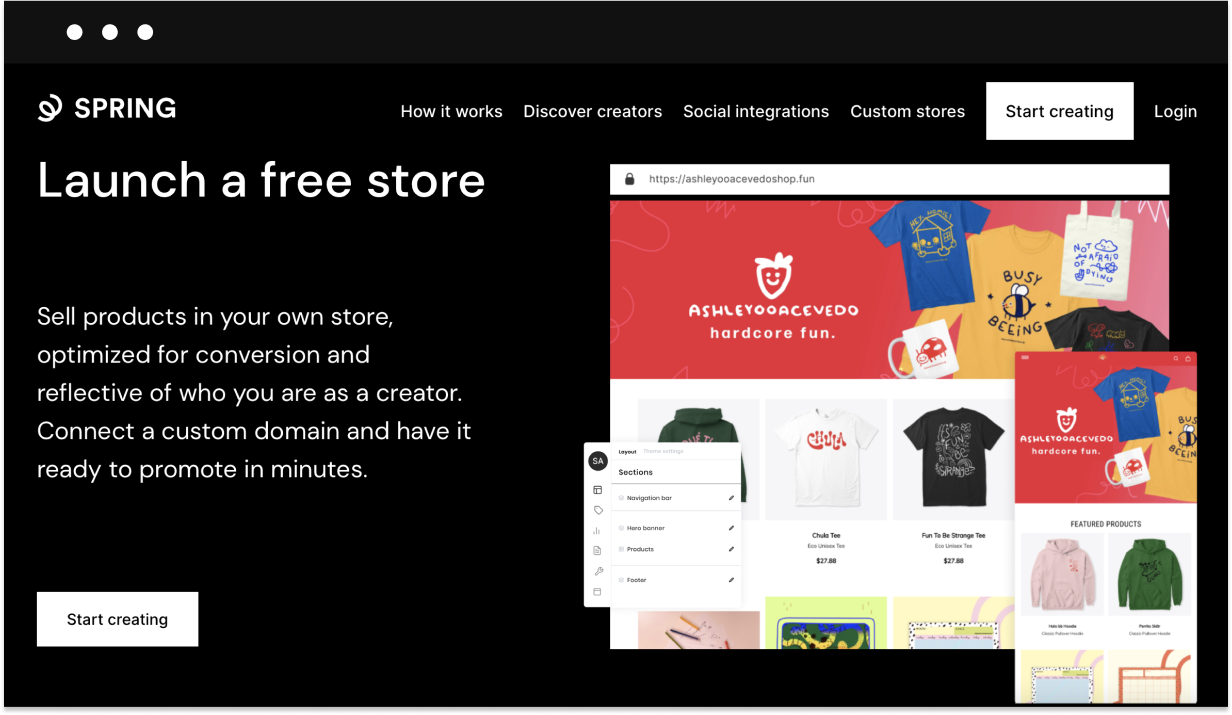
Teespring (now Spring) is a POD site that allows you to create and use original designs to sell custom merch. The company has a controversial past but, despite that, they’re still popular.
Just like Sellfy, Teespring will handle everything for you: printing and shipping POD products whenever an order is placed.
One common misconception about Teespring is that you can only run limited-edition campaigns. It isn’t entirely true.
Here’s how it actually works:
Teespring lets you set up a basic online store for your merchandise with built-in marketing tools. But, you still have to choose a campaign length for your product line, which can last anywhere between 3–21 days. This means that Teespring will collect all orders placed every 3 days, and only then print and ship them to your customers.
On a bad note, Teespring heavily limits the design space on the front/back of the shirt—you can’t get that creative with your designs. This makes it easier for Teespring to print on shirts but prohibits very creative designs that take up the entire shirt. So, no sleeve designs or anything like that.
Best for: Newbies and small POD businesses. If you’re planning to scale up your small business or sell something else apart from POD products, it’s better to look at other options. You cannot integrate Teespring with your existing online store or website.
How you get paid: Apart from instant payouts, Teespring’s charging system is somewhat similar to Sellfy’s. You’re only charged for the cost of the product and its fulfillment services after a sale.
E.g. Your Selling Price ($30) – Teespring Cost ($15) = Your Profit Margin ($15)
Pros:
- Integrate Teespring with YouTube, Twitch, and other platforms
- A wide range of custom products
- Good customer service
- Straightforward setup
- Solid design process
- No minimums
Cons:
- Limited design space
- Limited marketing features
- Less control over branding and ownership
- No possibility to switch printing options (this affects print on demand quality)
3. Bonfire
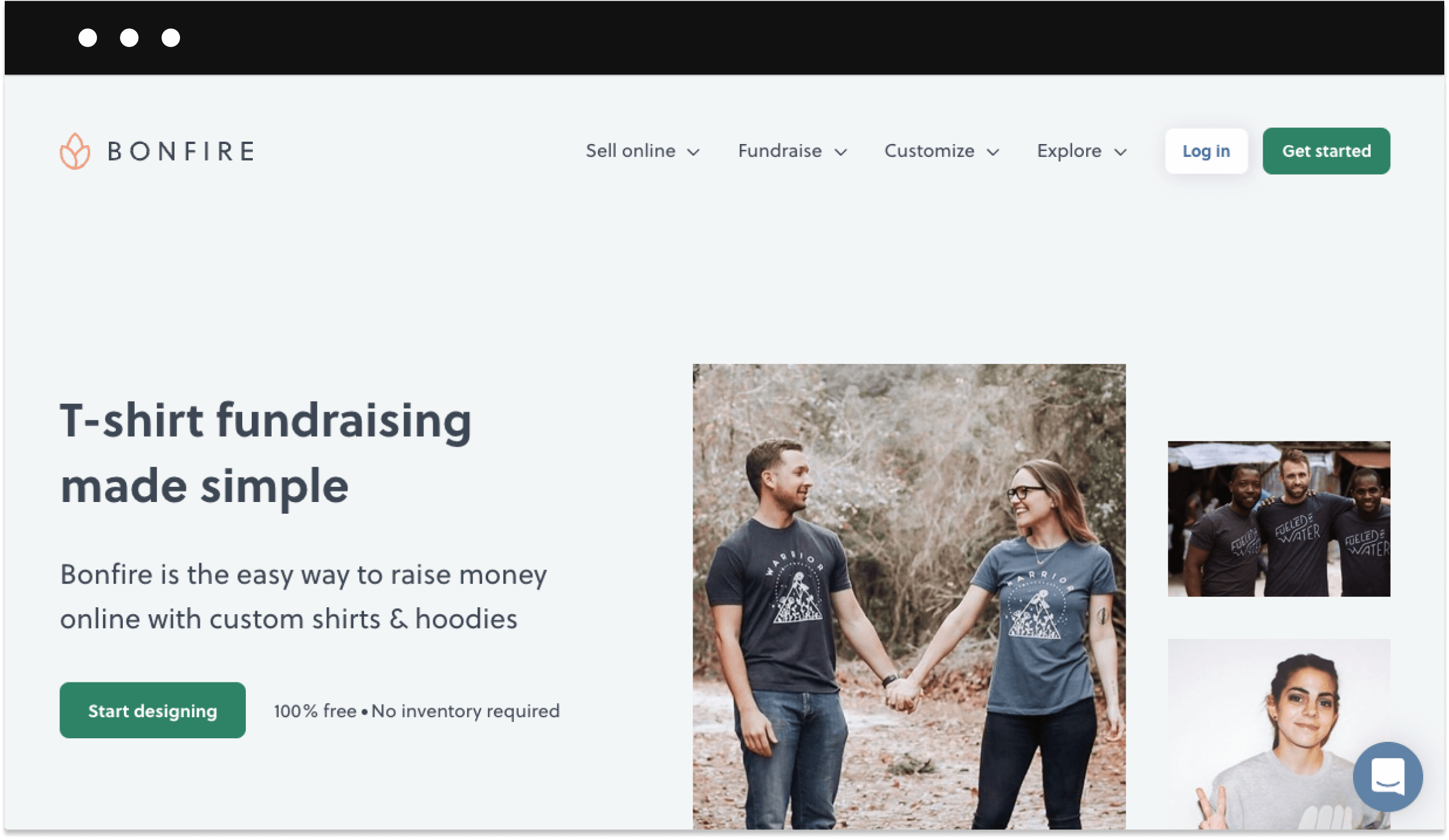
When you sign up on Bonfire, you can create a merch store or sell online in a campaign. This unique fulfillment model has attracted many individuals and nonprofits to their marketplace.
Here’s how Bonfire works:
You can either upload your custom designs or create them from scratch using their built-in mockup generator with a limited selection of free graphics. Once you’ve created your custom products you can launch a campaign that lasts 7–21 days.
Bonfire lets you create a custom storefront with a relatively easy-to-use interface. However, its customization is limited. Plus, they keep the Bonfire brand visible in your online store and won’t let you use a custom domain.
Best for: Running all kinds of fundraising campaigns.
How you get paid: When your campaign is over and you’ve met your goal, you get all the profits. You can decide how to price your custom products depending on your fundraising goals.
Pros:
- Free online store
- Selection of free graphics
- Run fundraising campaigns
- Social media integration
Cons:
- Limited customization with no white-label
- No built-in marketing tools
- Sales minimum to reach the payment threshold
4. Redbubble
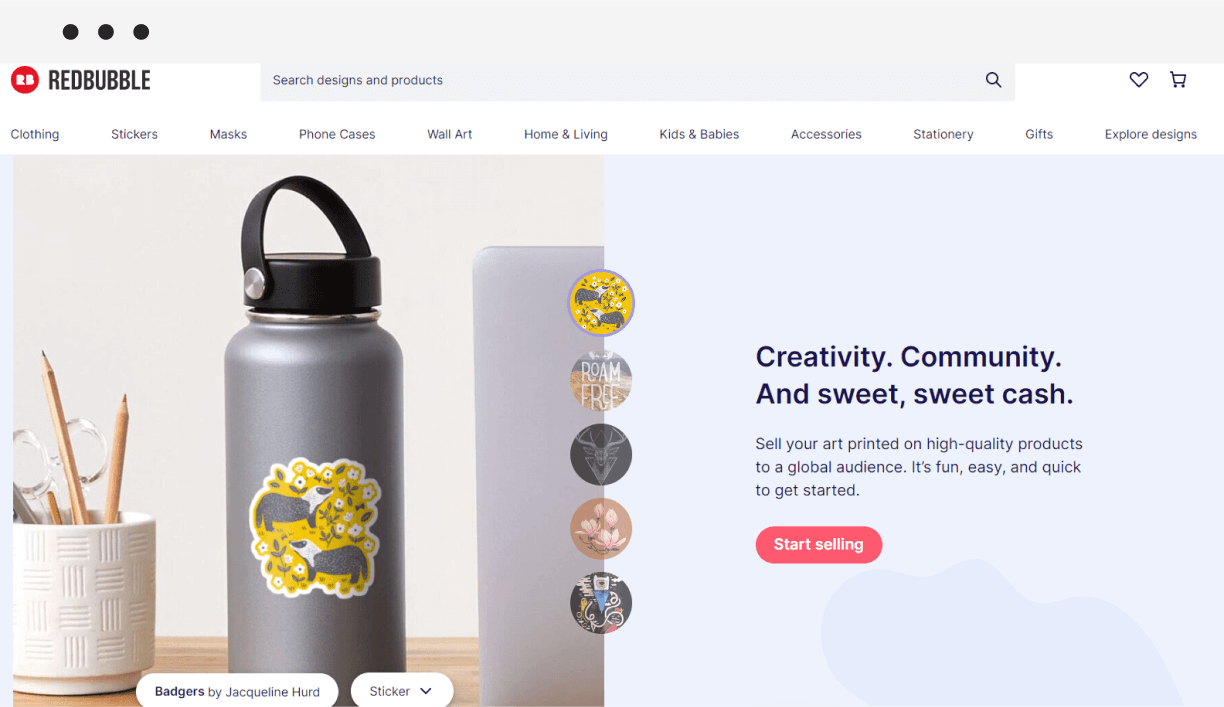
Redbubble is one of the biggest print-on-demand marketplaces that help independent artists create and sell custom products with their own unique designs.
Thanks to the huge online presence, Redbubble gets tons of organic traffic. It means that you have a pretty good chance of having your designs show up on Google.
Here’s how Redbubble works:
- You create an account
- Upload your artwork, choose products, and set pricing.
- Name your products, add descriptions and assign relevant tags (keywords).
- Finally, publish your custom products.
While Redbubble is one of the main players in the print-on-demand service industry, it’s still a marketplace. There’s no possibility to create an online store or integrate it with your own website. Instead, you list your products directly on Redbubble, competing with thousands of other sellers. And the competition there is ridiculous.
In other words, it’s hardly the best option for creators or businesses looking to launch branded merch.
Best for: Independent artists and buyers looking to purchase unique designs.
How you get paid: The retail price of each item combines the base price and the artist margin. The base price includes fulfillment and shipping costs. Artists get the freedom to decide their own artist margin. Thus, you have better control over how much you can make selling your custom products.
Pros:
- Straightforward setup
- Prominent online presence
- Wide product range
- Worldwide printing and shipping
- Free fully-featured marketplace
Cons:
- Fluctuating base price
- No branding possibility
- Monthly payouts
- No eCommerce integrations
- Oversaturated market (too tough to get noticed)
5. Spreadshirt
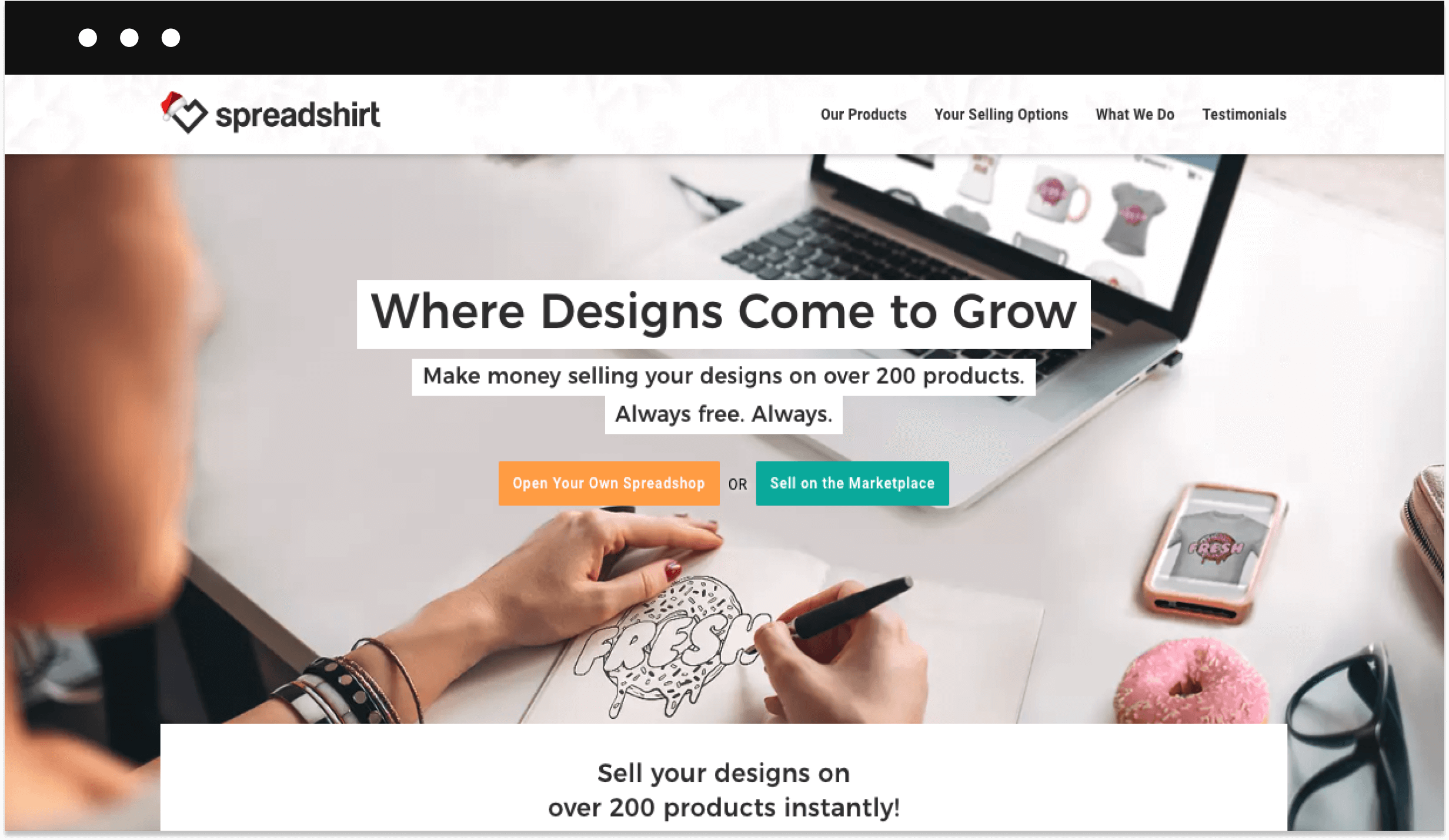
Spreadshirt is an unusual print-on-demand service platform that offers services centered around designers. Essentially a POD marketplace, Spreadshop lets you sell designs without having to worry about creating an online store. Moreover, other Spreadshirt users can also sell your designs which will earn you a commission on each sale.
The setup is quite similar to Redbubble (minus the huge online presence). When you list your designs on the marketplace, you get free traffic through Spreadshirt’s own marketing.
However, Spreadshirt only pays you a percentage for each sale, which is much lower than what you could get if you were selling the designs yourself.
If you’re looking for more control over your business, you can open up your own Spreadshop—a storefront where you can list and sell your designs. But, it’s still not the best option for selling branded merchandise because their stores have limited customization and no white label. Plus, once you start a Spreadshop, your items won’t be featured on the main marketplace.
Another downside is that Spreadshop has quite a limited product catalog and low print quality.
Best for: Independent artists and designers.
How you get paid: The final cost combines the product base price and your design price. You get to set your design price (the limit is $15) regardless of the chosen distribution channel. In case you have your own Spreadshop, you can get an additional 20% of the product base cost.
Pros:
- Free fully-featured marketplace
- Possibility to create a separate store
- Access to product mockup photos on Placeit
- Worldwide printing and shipping
Cons:
- Low print quality
- Limited product catalog
- No eCommerce integrations
- No white-label or support
- Limited color options
6. Printful
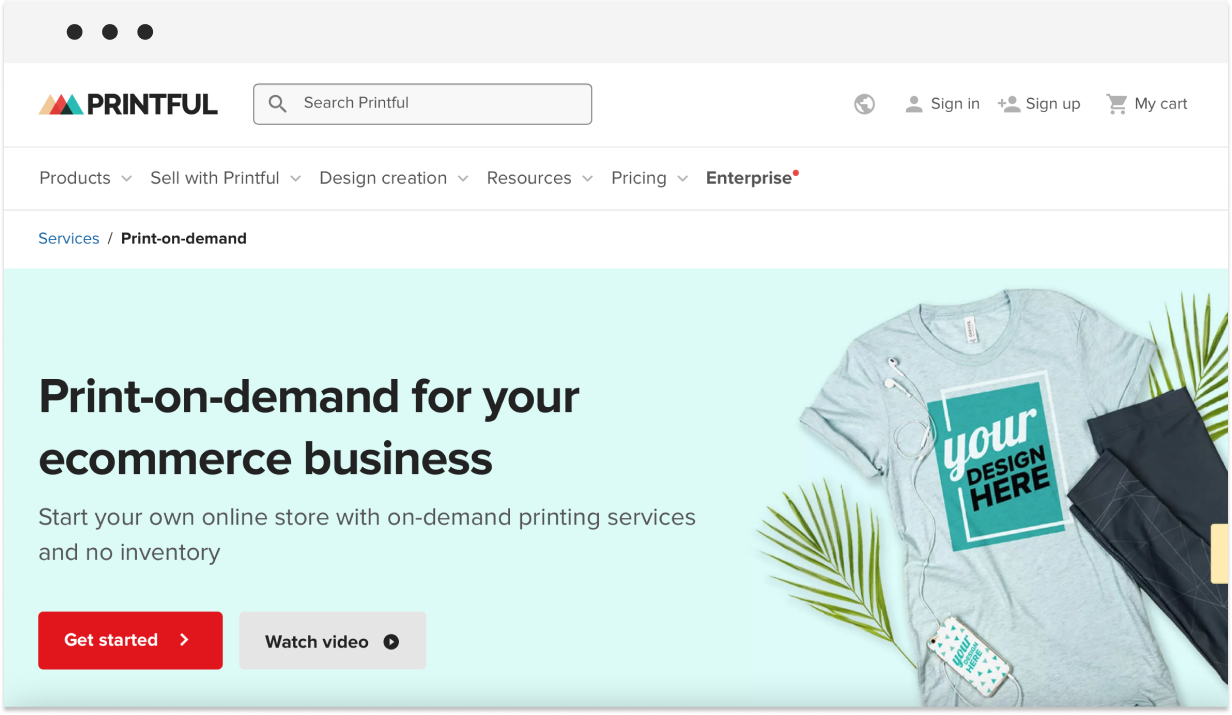
We’ve explained the difference between print-on-demand sites and print-on-demand companies earlier in the article. Sure, a print-on-demand site is a much simpler and quicker way to create and sell custom products. But if you need a POD platform to integrate with an existing eCommerce business, Printful is an excellent option.
Printful has been one of the most popular print-on-demand companies for a couple of years now. They offer a solid solution with tons of useful features that can help you start and scale your POD business—from a great product selection and a powerful mockup generator to custom services like logo design.
On top of that, Printful lets you brand your products and packaging for an additional cost.
Sounds too good to be true? The catch is that you can’t use Printful as a standalone solution as you have to integrate it with an existing eCommerce store. The good news is that Printful integrates with 15+ eCommerce platforms and marketplaces.
Best for: Business owners with an existing eCommerce store.
How do you get paid: There are two transactions for every order:
- The customer is charged with the set retail price
- Printful charges you for the order fulfillment
Whatever is left over is your profit margin.
Pros:
- Wide POD product selection
- Integration with major eCommerce platforms
- Easy to use
- Worldwide printing and shipping from warehouses all over the world
- Guarantee policy for lost or damaged packages
- 24/7 customer service
- White-label and product personalization
Cons:
- Not a standalone solution
- Big product base cost
- No returns or refunds unless products are damaged or lost
7. Lulu xPress

If you’ve ever thought about selling books online, you must know that you might face some challenges looking for a suitable print-on-demand service platform. The biggest one is the minimum requirement for a certain amount of books to be purchased before any of them are produced.
This is the first online platform that might solve the majority of problems faced by self-publishers.
They require no product minimums for ordered books. On top of that, you get flexible formatting options, worldwide printing and shipping, as well as reasonable fulfillment and delivery time.
Aside from books, they have an admirable selection of products:
- Novels and poetry books
- Photobooks
- Cookbooks
- Journals
- Workbooks and textbooks
- Artbooks
- Novelty coffee-table books
- Calendars
- Magazines and comic books
However, just like Printful, you cannot use them as a standalone solution. You would have to build a website or an eCommerce store in order to collect your orders before they print and ship them.
Best for: Independent authors, illustrators, and creatives of all kinds who want to monetize their talent or their audience with a book or calendar product.
How you get paid: The pricing may appear a bit complex, but that’s because they offer a variety of prints and formats to choose from. You have to set product specifications such as the number of pages, colors, paper, binding type, etc. And only then the final price is calculated.
Pros:
- Easiest setup among all self-publishing platforms
- No product minimums for printing
- Reasonably fast printing and shipping
- High product quality
- Low prices for book printing
Cons:
- No eBooks distribution
- Reported printing partner/distribution delays
- Additional costs (formatting, illustrations, etc.)
- Poor customer service
8. Society6
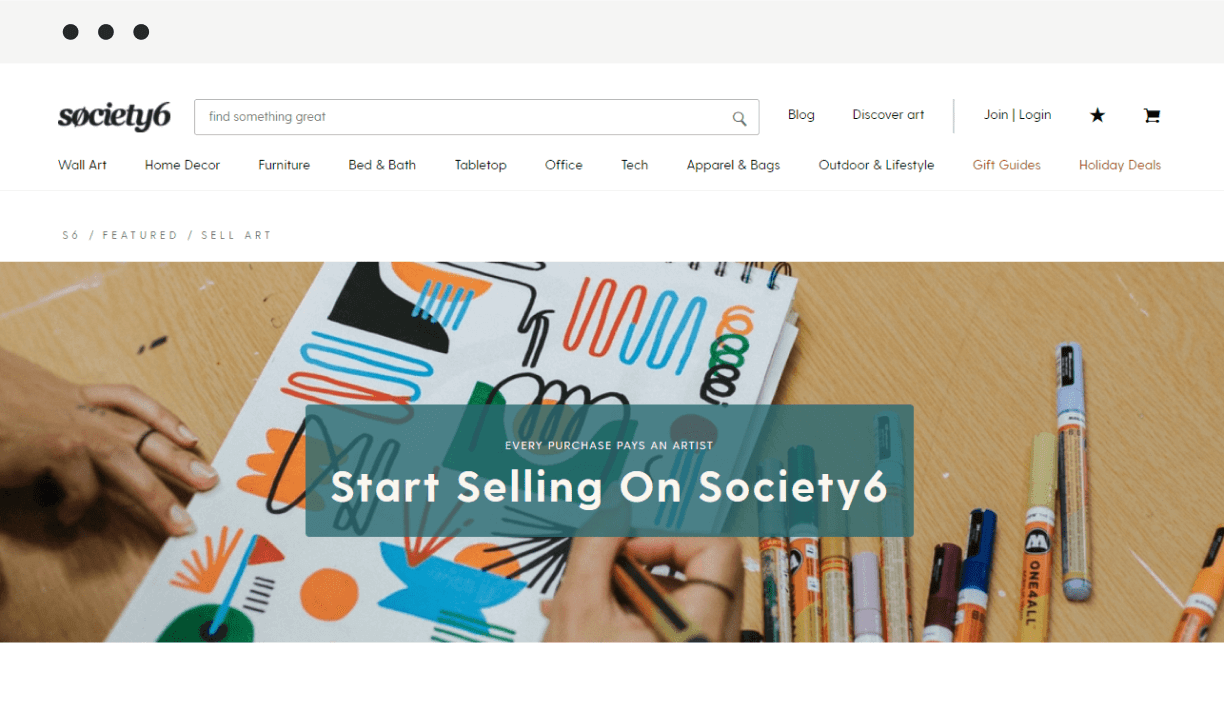
Society6 is yet another popular print-on-demand marketplace. However, there’s one thing that sets it apart from the rest:
Society6 centers around high-quality art prints (e.g. home decor, wall art). Plus, any artist on their platform can become a curator and earn a commission for recommending the work of fellow artists.
Society6 might not have the biggest organic traffic the wayRedbubble or Spreadshop does, but its huge social media presence partially compensates for that. Just keep in mind that the smaller the organic traffic, the lesser the chances that people will discover your customized product.
Even though Society6 is laser-focused on supporting the artist community, it might not be the best place for creating branded merchandise. Apart from the organic traffic that brings in new customers, the platform doesn’t have any built-in marketing tools.
Best for: Indie artists with a specific aesthetic (e.g. florals, patterns, abstract wall art, etc.).
How you get paid: Unlike other POD platforms, Society6 doesn’t let you set your own prices. Instead, the platform itself sets a price, and you get only 10% on each sale. The only exceptions are art prints, framed prints, and canvas prints, which you can markup beyond the default 10%.
Pros:
- Fills a well-defined niche
- Large brand-aware audience
- Decent social media following
- Good customer service
- Possibility to earn commission as a curator
Cons:
- No white-label
- Low organic traffic
- A style that may not fit everyone
- Complex upload process
- No price markup on products
9. TeePublic
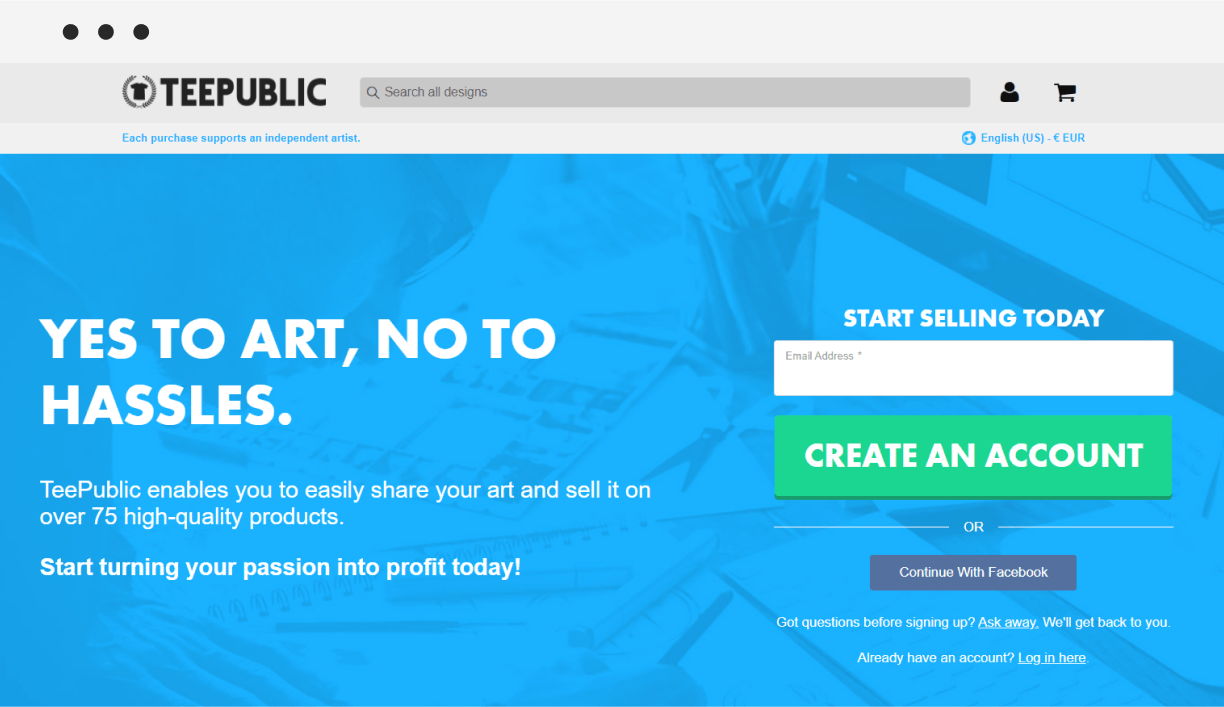
TeePublic is a marketplace where designers showcase their work on apparel and other print products. It has the second-highest organic traffic after Redbubble. That means it does a decent job at driving potential customers to its marketplace.
TeePublic is well known for the easiest design upload process among all print-on-demand service platforms.
It also gives customers the option to hire a designer, so if anyone’s browsing TeePublic and likes your style, they can hire you for design gigs.
One thing that sets TeePublic apart from the rest is fixed royalties for your work—you can’t set the price for your own products. As bad as it sounds, it automatically saves you from your work being copied.
Best for: Designers and artists looking for creative ways to showcase their work.
How you get paid: TeePublic doesn’t let you set an artist margin for your designs. All products have two pre-defined prices—a regular price and a sale price.
Pros:
- Easy upload process
- Decent organic traffic
- No startup fee
- Possibility to get hired as a designer
Cons:
- Low fixed royalties
- No white-label or branding options
- Copyright infringement issues
Which print-on-demand site fits you best?
Is print on demand profitable? There’s no doubt about that. But the choice of the platform depends on your goals and how much work you are willing to invest in promoting and growing your brand.
For those who are looking for full control over their POD business, Sellfy is by far the best choice. It requires a small monthly fee, but you get a 100% customizable store, great built-in marketing features, and excellent customer service. Plus, they have an effortless setup process.
But if you just want to list a few products for friends or to showcase your artwork, marketplaces like Redbubble, TeeSpring, or TeePublic are likely to be your best options.
FAQ: best print-on-demand sites
What is print-on-demand?
Print-on-demand (POD) is a fulfillment model where products with your designs, such as apparel, accessories, and home goods, are produced by a supplier only when an order is placed. With POD, holding inventory or investing in upfront production and shipping costs is unnecessary. Products are printed and shipped on demand and under your brand, allowing for customization and reducing financial risk for sellers.
Is print-on-demand profitable?
Print-on-demand can be a profitable business model. By leveraging POD services, sellers can avoid inventory and shipping costs and only fulfill orders as they come in. This eliminates the risk of holding excess inventory and allows more flexibility in testing different products and designs. Profitability depends on factors such as product quality, pricing strategy, marketing efforts, and finding the right target audience.
Which eCommerce platform is best for print-on-demand?
When it comes to choosing the best eCommerce platform for print-on-demand, Sellfy is an excellent option. Sellfy provides a user-friendly platform with built-in print-on-demand service functionality. It offers customizable storefronts, secure payment processing, and analytics to track sales and customer engagement. With Sellfy, sellers can easily upload their designs, set prices, and sell a variety of POD products, making it a reliable choice for print-on-demand businesses.






